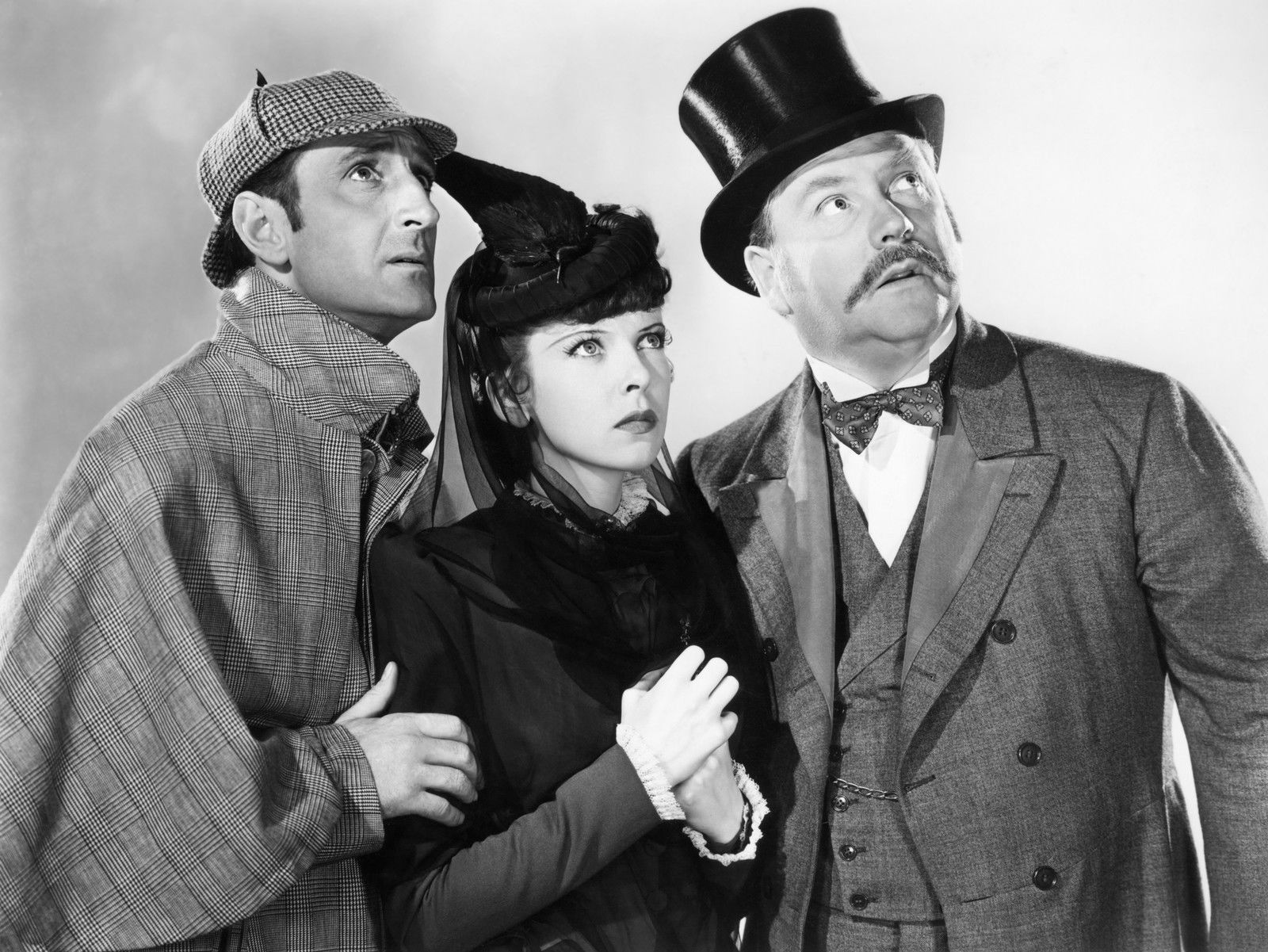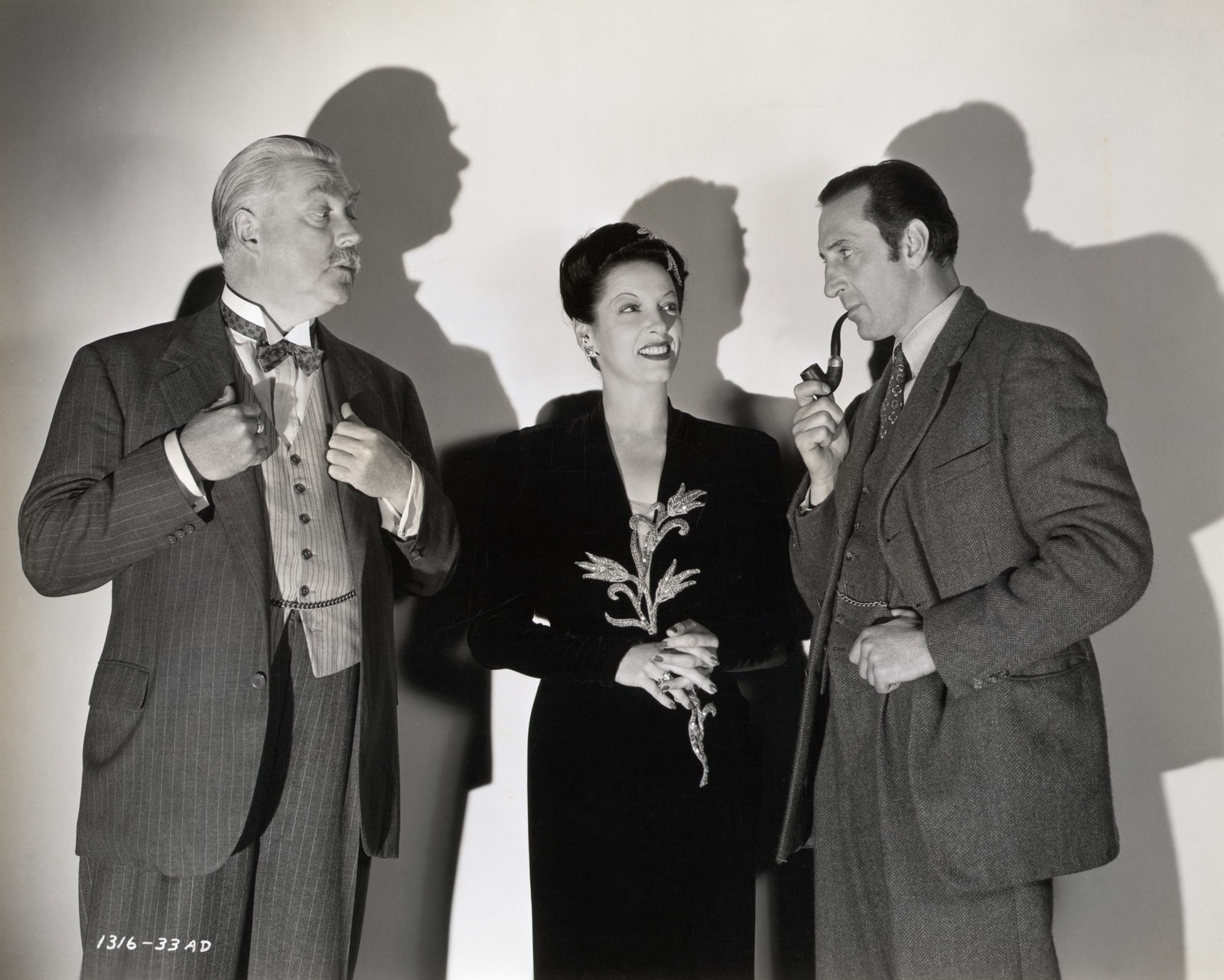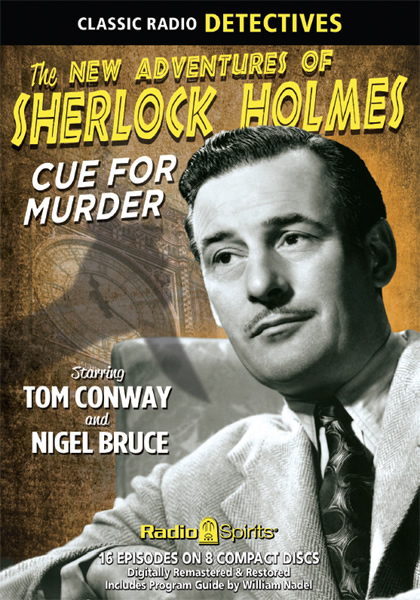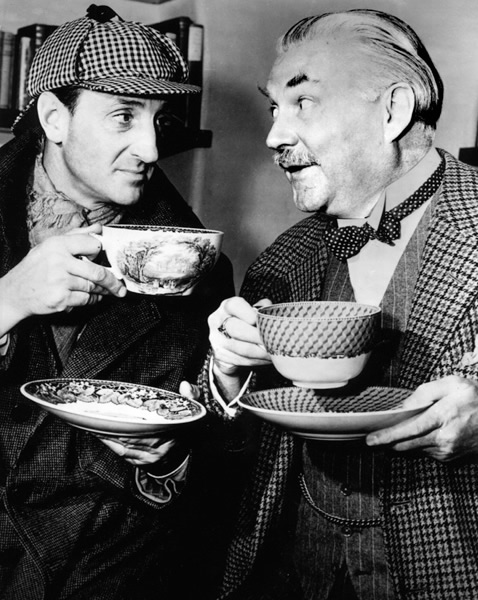Happy Birthday, Nigel Bruce!
Posted by Ivan G. Shreve, Jr. on Feb 14th 2015
If we can suggest a word association exercise for the old-time radio devotees and classic movie fans who drop by the blog on occasion…what would be the first thought to come to mind upon the mention of “Nigel Bruce”? We’d bet dollars to donuts the largest percentage of answers received would be “Dr. Watson.” Playing the physician sidekick of the legendary detective Sherlock Holmes is unquestionably the English actor’s most memorable role. But we’d also be doing William Nigel Ernle Bruce—“Willie” to his close friends and born on this date in 1895—a grave disservice; though he was immortalized on the silver screen as the archetypal bumbling Englishman, Bruce did more than just aid and abet Basil Rathbone’s Sherlock Holmes in over a dozen celluloid investigations and 200 radio broadcasts. For example, Nigel had substantial roles in two classic Alfred Hitchcock films, Rebecca (1940) and Suspicion (1941).
The English actor was born the second son of Sir William Walter Bruce and Lady Angelica Bruce…though interestingly enough, not on British soil; his birthplace was Ensenada in Mexico’s Baja California, a little surprise to his parents as they vacationed there. His schooling took place in his home country, however, and after a brief job with a stockbroker’s firm Willie enlisted in the service—achieving the rank of lieutenant in the 10th Service Battalion of the Somerset Light Infantry and the Honourable Artillery Company. Like his silver screen counterpart Dr. Watson, Bruce suffered an injury (taking eleven bullets in his leg at Cambrai) during his military stint; Bruce was forced to spend the remainder of the war wheelchair-bound.

This wouldn’t be a setback in the acting career that Nigel Bruce set his sights on; his stage debut was as a footman in a 1920 production of Why Marry?, and he later appeared in such plays as The Ringer, Lean Harvest and Two White Arms. Bruce’s credited film debut is believed to be in a 1929 silent entitled Red Aces, and he later graced such British-made films as The Squeaker (1930) and I Was a Spy (1933; with Conrad Veidt and Madeleine Carroll). Nigel still continued to be active in the footlights, but his move to Hollywood in 1934 opened up many more motion picture opportunities: the films on his resume at that time include Stand Up and Cheer (1934), Treasure Island (1934), She (1935), The Trail of the Lonesome Pine (1936), The Charge of the Light Brigade (1936), and The Last of Mrs. Cheyney (1937). Bruce also appeared in Becky Sharp (1935); the first feature film released in full Technicolor.
Many of his movie roles were consistent with the lovably absentminded British twits that became his stock-in-trade—though Nigel Bruce wasn’t afraid to expand his range when needed, playing a particularly loathsome sort in 1939’s Oscar-nominated The Rains Came. It was also in 1939 that Bruce was cast as Dr. John Watson in 20th Century-Fox’s production of The Hound of the Baskervilles, based on Sir Arthur Conan Doyle’s novel. The chemistry between Willie and Basil Rathbone (as Holmes) was positively perfection (the two actors were close friends even before shooting on Baskervilles began), and a follow-up from the same studio was released that same year, The Adventures of Sherlock Holmes. (Adventures was based on the famed William Gillette play and not Conan Doyle material…but the film has quite a few admirers, notably for the first-rate casting of such thespians as Ida Lupino, George Zucco, Henry Stephenson and E.E. Clive.)

Their success in the two Fox films would pave the way for Nigel and Basil to reprise their characters in a Sherlock Holmes radio series that premiered over NBC in the fall of 1939. We need to stress that this was not the first time Arthur Conan Doyle’s sleuthing creation was heard before the microphones; Sherlock Holmes had been entertaining listeners as far back as 1930. But the teaming of Rathbone and Bruce on the radio was undeniably the most celebrated of the various Holmes series incarnations; the duo broadcast for Bromo Quinine for two seasons on the Blue network, then switched to NBC for a season with the same sponsor. In April of 1943, The Adventures of Sherlock Holmes moved to Mutual, where Petri Wines agreed to pick up the tab.
At the same time the radio series was on the air, Bruce and Rathbone were the stars in a Sherlock Holmes film franchise that began at Universal in 1942. Though signed to an MGM contract in 1941, Rathbone was generously loaned to Universal for each entry in the movie series, beginning with Sherlock Holmes and the Voice of Terror (1942). That entry was helmed by John Rawlins, with each subsequent film featuring Roy William Neill in the director’s chair; Neill had an incredible talent for making B-pictures (which the Universal Holmes films clearly were) look lavish despite their miniscule budgets. Despite an ill-advised decision to update the first three films to the modern era (as well as saddling Rathbone with a risible haircut), the remaining installments (well, with the exception of 1944’s The Spider Woman) operated in a quasi-Victorian period that occasionally echoed the era depicted in Baskervilles and Adventures.

The Universal Sherlock Holmes films were treasured by movie audiences, but they often came under criticism by devoted Sherlockians, who objected to the portrayal of Dr. Watson on screen by Nigel Bruce. The dispute was with Bruce’s interpretation of Watson as a not-too-terribly bright sidekick who fumbled and harrumphed his way through the investigations, the very picture of foggy bewilderment. Conan Doyle’s Watson was an intelligent man (he would have had to have been, seeing as he was a physician and all) whose intellectualism paled in contrast to the brilliance of Holmes. I’ve long dismissed this nitpicking; Bruce’s performances were infused with a lovability that his co-star Rathbone later championed in his 1961 memoir In and Out of Character: “There was an endearing quality to his performance that to a very large extent, I believe, humanized the relationship between Dr. Watson and Mr. Holmes.” Their relationship on both film and radio was an engaging one, but all good things eventually come to an end; by 1946, Rathbone believed playing Holmes had grown stale, and he informed Universal that Dressed to Kill would be the final time he dawned the deerstalker hat and inverness cape. Basil left the radio series as well at the end of the 1945-46 season, with an eye on working on stage for a while.
Nigel Bruce, on the other hand, wasn’t ready to cease being Dr. Watson; he soldiered on in The New Adventures of Sherlock Holmes with Tom Conway taking on the titular role. Nigel got a hefty raise and top billing on the show…but tensions between the writers and the series’ producer made the experience an unpleasant one for Bruce, and so he relinquished the Watson part at the end of the season. He could certainly afford to do so; his career as a beloved character actor was in full swing, as he racked up appearances in such films as Journey for Margaret (1942), Lassie Come Home (1943), Son of Lassie (1945), The Two Mrs. Carrolls (1947), Limelight (1952) and Bwana Devil (1953), the first 3-D film. Bruce passed away at the age of 58 on October 8, 1953—his final film (released posthumously) was 1954’s World for Ransom.

Radio Spirits’ latest CD collection Great Radio Detectives features today’s birthday boy opposite his friend Basil Rathbone in a November 6, 1939 broadcast of “The Bruce Partington Plans.” We’ve also got a new set of cases from The New Adventures of Sherlock Holmes (with Tom Conway as Holmes) in Cue for Murder, as well as our classic compilation The Stuttering Ghost & Other Mysteries. It’s Nigel Bruce at his beloved bumbling best, and we wish one of our favorite character thesps a most happy birthday!

